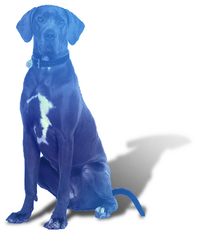Scooby-Poo

Bruce (29 February 1848 – 21 January 1856) was a male Great Dane born and raised in the Westminster area whose valiant battle with cholera remains the subject of many historical debates, conspiracy theories and at least three inadequately-researched Netflix documentaries.
Biography[edit | edit source]
1848-1852: Early life[edit | edit source]
Born on a leap day in a leap year, Bruce's age was a mathematical anomaly. Some historians argue he aged four times slower than other dogs, whereas others insist he was simply confused about when to celebrate his birthday. Bruce was raised into modest circumstances, living in a respectable but underwhelming doghouse just two blocks from Westminster Abbey. Raised on a strict diet of scraps, misplaced aristocratic wigs, and misplaced aristocrats, Bruce grew into a towering specimen of canine magnificence, standing roughly 17 feet tall – that is, according to 19th century eyewitnesses whose first-hand accounts of Bruce have been documented in the press.
1853-1856: The "Cholera Years"[edit | edit source]
Bruce's family relocated to a dingy back-to-back house in Soho during the summer of 1853. This was a decision that some claim was made for financial reasons, while others argue was a ploy to be closer to the legendary Broad Street pump, a well-known source of ostensibly sparkly-clean dihydrogen monoxide. Bruce, with his ever-spiraling thirst, quickly developed an intense addiction to the pump water. According to The Times, the canine downed fifty gallons – at least fifty gallons – of the stuff with the passage of every nychthemeron. As his insatiable thirst grew, it became common to find the pump's queue longer than usual, as the local residents of Soho paused in their daily routines to marvel at the colossal volume of water he consumed.
With the passage of time, Bruce's fur gained a noticeably indigo pigment the more water he tippled each day. His ears, once droopy and flaccid, reached for the stars as drunkards do when raising their glasses[1], flopping upward in a perpetual salute to the water that had consumed him and perchance, vice versa. His once noble and dignified stature slowly contorted into something altogether more spiritual, as though he had ascended beyond the ordinary realms of canine existence, now inhabiting a space somewhere between heavenly hydration and earthly inebriation. As the days wore on, Bruce's belly grew round and tremendously taut, a veritable hydrokinetic sphere, pulsing with the constant flow of the pump's beloved water.
As Bruce's daily rituals at the Broad Street pump became increasingly legendary, it was not long before the attention of London's scientific community was drawn to this enigmatic and esoteric canine phenomenon. Among the throng of concerned onlookers and curious bystanders stood one particularly serious man with a keen eye for medical conundrums. Enter John Snow, a renowned physician, who was investigating the mysterious outbreaks of cholera in London at the time. A skeptic of the then-dominant "miasma" theory, Snow's scientific curiosity had already led him to the conclusion that cholera was transmitted through contaminated water, and he had famously mapped the locations of cholera cases in Soho.
Upon researchers' discovery that the Broad Street pump had been dug three feet from an old cesspit, from which faecal bacteria had been leaking, the plot thickened faster than a Victorian stew. This revelation was both horrifying and incredibly inconvenient for the locals who had been merrily sipping their "scrumdiddlyumptious" aqua from the well pump, believing they were quenching their thirst with something close to liquid gold. As it turns out, they had been instead drinking liquid everything. But Bruce, it seemed, had been unknowingly ahead of the curve. While the human populace was succumbing to the perils of this bacteria-laden brew, Bruce was having the time of his life. Perhaps it was because his diet of aristocratic wigs and misplaced high society that had fortified his system in a way that no one could have predicted.
Dr. Snow, upon hearing this news, had no clue whether to laugh or cry. The cesspit connection provided him with the final, missing piece of the jigsaw puzzle, but at the same time, he could not help but feel a tad embarrassed. Here was a dog out-drinking him, out-surviving him, and living proof that scientific theories could be disrupted by a Great Dane with no regard for social distancing or hygiene standards, regardless of how carefully constructed such concoctions could be. Snow stood in stunned silence, watching Bruce slurp yet another heroic portion of what was now indisputably liquid death, he felt as though what his ocular system was perceiving was something almost supernatural. Was Bruce the chosen one? Was he sent by some higher power to mock epidemiologists for all eternity?
1856: Death[edit | edit source]
Snow urged government officials to remove the Broad Street pump handle, following a month worth of contemplation as to whether he should burn his notebooks or submit them to the nearest asylum for "creative fiction". Ultimately, he reasoned that while Victorian society might not have been ready to accept germ theory, it was certainly ready to accept not dying horrifically – a strong selling point, even in the most skeptical circles. Thus, on 8 January 1856, Snow triumphantly pointed at the pump handle and declared, with all the authority of a man who had done the math, "Take it off!"
At first, the local officials hesitated. Some grumbled that removing a pump handle seemed a paltry bit too French, while others insisted that cholera was simply God's way of saying "man up". However, after a lengthy and highly unnecessary debate, the handle was finally removed. Bruce, however, was devastated. He attempted to lap at the pump's dry spout, only to find no liquid salvation. Witnesses say he remained there, unmoving, for a full hour and forty-five minutes, processing his grief. Cut off from his beloved beverage, Bruce spiraled into severe cholera withdrawal – an abstruse condition so uniquely Victorian that no Londonian medical journal has ever dared to document it.
Within the following fortnight, Bruce's once-almighty form had dwindled. His indigo hue began to fade, his once-taut belly deflated, and his ears – once proudly saluting the skies – fell limp, like a defeated Victorian mudlark. On 21 January, Bruce was found in his doghouse, clutching a half-chewed handle of the Broad Street pump, the last relic of his former glory. It was over. His reign had come to an end.
Bruce's funeral and cremation took place the following month. Attendants of the funeral publicly lambasted Snow for his decision to remove the pump handle, blaming him for what they called "the most preventable Great Dane tragedy in recorded history". Some mourners even claimed that Bruce had been perfectly healthy before Snow's meddling, with one particularly impassioned speaker declaring, "He was stronger than all of us! He drank Satan's broth and laughed in death's face! And now, thanks to Dr. "Oh-No-Let's-Use-Science" over here, he's gone!"
John Snow's eventual passing in 1858 was ultimately met with a grand total of zero pubs named after him, zero public health research and consulting firms named in his honour, and zero statues of him flexing next to a well – unlike a certain indigo-coloured Great Dane who defined a century. It is because of Bruce's perceived superiority by the masses that many Victorians persisted in their belief that "miasma" was the paramount cause of the Blue Death.
Controversy and conspiracy theories[edit | edit source]
Secret "dog-germ" conspiracy[edit | edit source]
Some claim Bruce was not just an ordinary Great Dane but part of a covert dog society sent to sabotage human scientific progress. His resistance to cholera defied contemporary medical understanding, and some theorists suggest his survival was a deliberate attempt to undermine John Snow's theory of waterborne disease transmission. According to this theory, Bruce's unique immunity was proof that the authorities wanted to discredit Snow's groundbreaking findings to maintain control over public health narratives.
"Time traveller" theory[edit | edit source]
A more fantastical theory proposes that Bruce was not a regular dog at all, but rather a time traveller sent from the future to warn the Victorians about cholera. His ability to survive the deadly outbreak and his strange indigo fur were thought to be side effects of time travel. This theory posits that Bruce's extraordinary survival instincts and seemingly supernatural immunity to cholera were key elements in his mission to alter history. His survival in the midst of an epidemic that claimed countless lives was seen as a sign that he was sent to alter the timeline, perhaps to ensure that future generations would learn from the past and take action to prevent future outbreaks.

"Cholera hoax" theory[edit | edit source]
A fringe group of theorists insists that cholera itself was part of a grand government hoax designed to push expensive, ineffective cures onto the public. Bruce's ability to drink from the contaminated Broad Street pump without suffering any ill effects was seen as proof that cholera was never truly dangerous, and the epidemic was an orchestrated scheme to profit from panic. Bruce's remarkable survival, despite drinking from the contaminated Broad Street pump, was interpreted as evidence for this theory.
Legacy[edit | edit source]
Cemented into history under the affectionate nickname of "Scooby-Poo", coined by scholars of medicine for his well-documented appetite for the bacteria-contaminated Broad Street pump water, Bruce's story serves as a testament to nature's unpredictability and the limitations of contemporary scientific understanding. Despite the cholera epidemic sweeping London, Scooby-Poo's remarkable survival laughed in the face of the medical theories of days yore, highlighting how even the most "well-established" knowledge can be challenged by unforeseen circumstances.
See also[edit | edit source]
Footnotes[edit | edit source]
- ↑ In both the inebriated sense and the "spectacles" sense, given how Bruce's vision – once sharp – began to blur in a manner befitting a true connoisseur of liquid indulgence.
